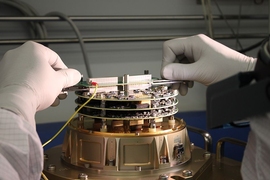How unique is our solar system? This is a question that scientists have been trying to answer for a long time. It is also the question that Natalia Guerrero posed during her keynote address at MIT Lincoln Laboratory's recent Hispanic Heritage Month event.
Guerrero is a researcher from MIT's Kavli Institute for Astrophysics and Space Research and the MIT communications lead for NASA's Transiting Exoplanet Survey Satellite (TESS) mission. TESS is a space telescope that launched in April 2018 on a mission to find exoplanets, or planets that orbit stars outside our solar system. She manages a team that identifies potential planets out of a sea of stars using data from TESS's images.
In her keynote address, she discussed TESS's most recent discoveries, as well as how learning about exoplanets will lead to a better understanding of where Earth belongs in the wide variety of possible worlds. "TESS has huge potential for giving us a glimpse of a vast expanse of sky at any given time," Guerrero said. She explained that exoplanets are statistically very common — for every star, there is likely at least one planet in orbit.
TESS detects these distant planets by observing the faint dimming of a star as an orbiting planet passes between it and the Earth. To make these detections, TESS uses four charge-coupled device cameras that were developed at Lincoln Laboratory. Since its launch, TESS has discovered 1,288 planet candidates from 15 sectors of the sky, with 29 of those now officially registered as planets.
After her keynote, Guerrero shared that she enjoyed drawing on the link between MIT and Lincoln Laboratory while developing TESS: "It was a beautiful thing, being able to take advantage of the existing bridge between MIT and the laboratory while extending my own MIT network to new connections at the laboratory. I've always appreciated and valued the quality of the TESS instrument, so it is exciting to see where its parts were made."
Guerrero, the daughter of Hispanic Americans, met with members of the Lincoln Laboratory Hispanic/Latino Network (HLN) and the greater laboratory community both before and after her talk.
Lincoln Laboratory staff member Alexander Serrano attended the keynote address and a lunch with Guerrero that was organized by HLN. "Natalia is remarkable in that she has a strong passion for making science education more accessible to the masses via public talks and outreach," he says. "This [theme of education] resonated with a lot of HLN members, including myself, who have also had similar academic journeys while growing up as first-generation American college students."
Eric Chaidez, co-chair of HLN, adds that Guerrero's talk was insightful and related to many technical topics that he and fellow researchers in the Space Systems Analysis and Test Group have worked on.
As one of Lincoln Laboratory's nine employee resource groups, HLN supports the community by coordinating recruitment and outreach activities, as well as opportunities for staff to gain leadership experience and showcase their technical work. This event was hosted by HLN to champion the technical achievements of the Hispanic and Latinx community at MIT.
"Events such as these allow participants to form strong professional networking relationships," Chaidez says. "It allows them to meet other community members, both within the laboratory and externally, that may be working on similar technical topics, or that may share similar ideas that can help the laboratory form coalitions with outside organizations for further outreach, diversity, and inclusion events."









